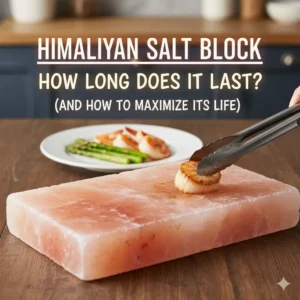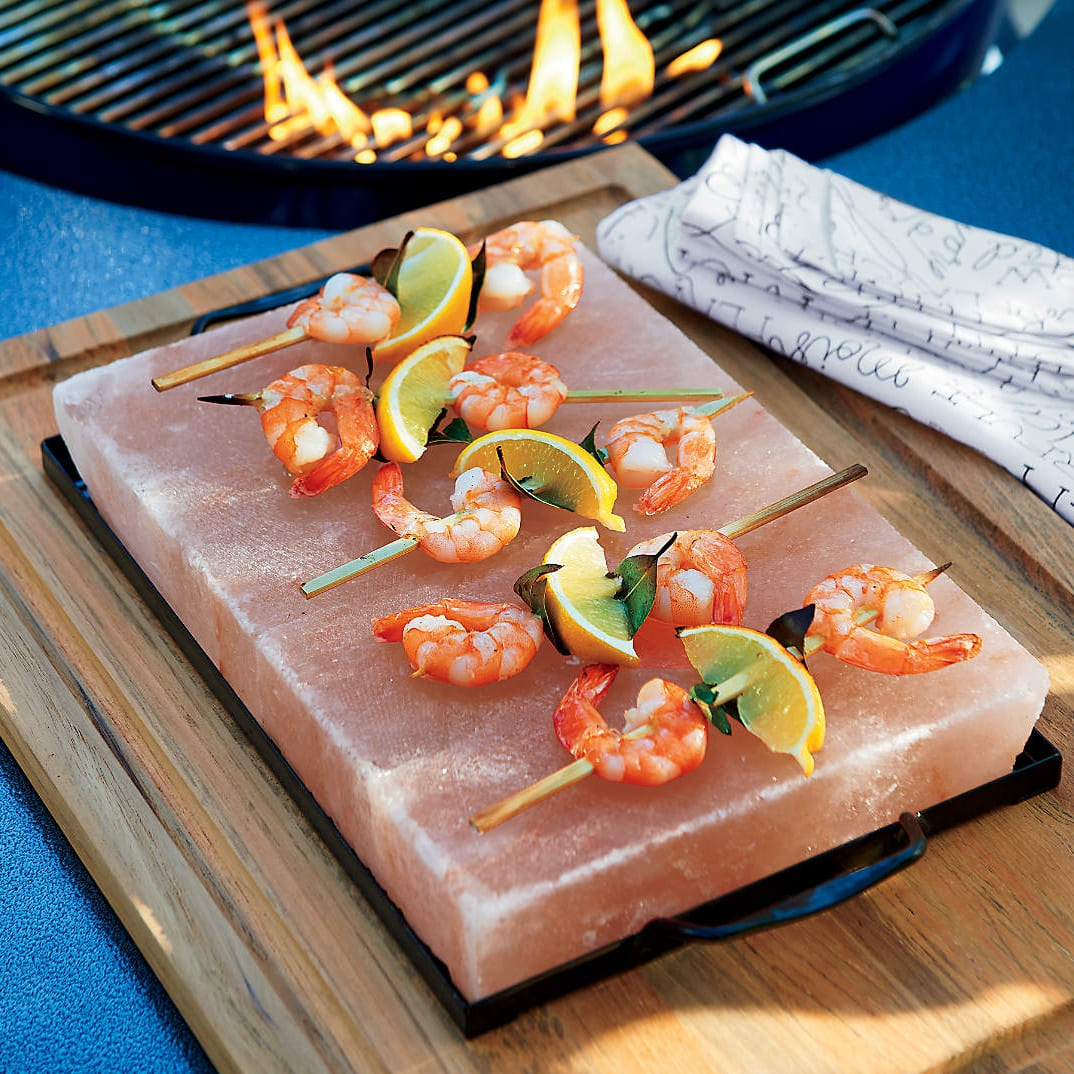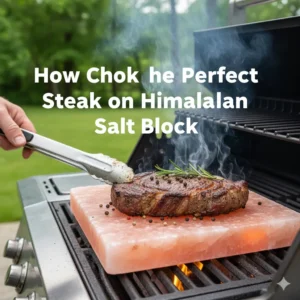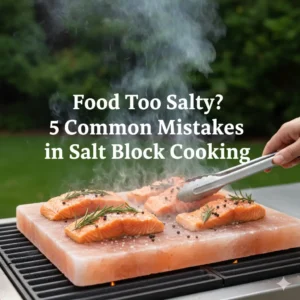A Himalayan salt block is a solid slab of mineral-rich rock salt used for cooking, serving, or presentation. Naturally antimicrobial and heat-tolerant, it enhances flavor while offering a striking, durable surface for professional culinary use. With proper heating, cleaning, and storage, it can serve reliably for years. This guide explains the main factors that determine its longevity and gives clear, practical steps to maintain strength, safety, and lasting value.

Prerequisites: Tools & Materials Needed
Before cooking or serving with a Himalayan salt block, prepare the right tools to ensure safe handling and lasting performance. The correct materials prevent fractures, surface erosion, and moisture damage while making upkeep straightforward.
- Food-grade Himalayan salt block (select a size suited to your intended use)
- Stiff brush for gentle cleaning after each session
- Soft, lint-free cloth or towel for drying and storing the block
- Mild oil (optional, for lightly seasoning serving blocks to reduce moisture absorption)
- Heat source suitable for salt block cooking, such as a grill, oven, or stovetop pan
These essentials make temperature control and maintenance easier, helping the block retain its structure and quality over time.
Step-by-Step Guide to Caring for Your Himalayan Salt Block
Step 1: Heat and Cool the Block Gradually
Rapid temperature changes are the primary cause of cracking in Himalayan salt blocks. To avoid this, introduce heat slowly. Begin with low heat for about fifteen minutes, then increase in small increments until the block reaches cooking temperature. This gradual process ensures the salt warms evenly and remains stable.
After cooking, allow the block to cool naturally at room temperature. Do not place it on cold or wet surfaces immediately, as sudden exposure to cool air or moisture can stress the crystal structure and cause deep fractures that shorten its usable life.
Step 2: Clean Carefully After Each Use
The salt surface gradually thins with every cleaning, so gentle handling extends its life. Let the block cool completely before cleaning. Use a dry or slightly damp brush to remove residue, adding only a few drops of water if necessary—but never submerge the block, as water dissolves salt and weakens its integrity.
Avoid soap or detergent, which can alter flavor and erode the surface unevenly. After brushing, pat dry with a soft cloth and leave the block to air‑dry fully. Keeping it free of moisture preserves its density and structural strength.
Step 3: Store in a Cool, Dry Environment
Because salt absorbs humidity, proper storage is essential. Once the block has cooled, wrap it in a dry cloth or store it in an airtight container. Place it in a cool, low‑humidity location away from sinks, stoves, or outdoor moisture.
For animal lick blocks, keep them off damp ground and under cover to prevent premature dissolving. Holders or trays improve air circulation and limit contact with moisture. Following these steps slows natural wear, helping the block maintain its form and function for years.
Premium Himalayan Salt Blocks for Culinary and Wellness
Partner with Jilin Ever Creation to source natural, food‑grade Himalayan salt blocks from the Khewra Salt Mine. Ideal for cooking, serving, and retail, these blocks age gracefully over years of use—gradually shrinking instead of expiring. Designed for durability and refined presentation, each block elevates flavor while retaining long‑term structural integrity with proper care.

Common Causes of Himalayan Salt Block Wear
Himalayan salt blocks are naturally durable, but certain conditions can accelerate their wear. Each time the block is heated, cooled, or exposed to moisture, trace amounts of salt dissolve or flake away. Over time, this gradual process makes the block thinner and more delicate, reducing its usable life.
Excessive heat and humidity are the main drivers of rapid deterioration. When a block is repeatedly subjected to drastic temperature shifts—such as moving directly from a refrigerator to a grill—internal stress can cause cracks. Even minor fractures may widen with continued use, creating uneven cooking surfaces and weakened structure.
Improper cleaning also contributes to wear. Using too much water or scrubbing too forcefully erodes the surface and removes protective mineral layers. Instead, rinse sparingly and dry promptly. Likewise, storing the block in a humid area or leaving it uncovered exposes it to moisture that dissolves salt at the edges, leading to premature shrinking and earlier replacement.
How to Identify When a Replacement Is Necessary
While a Himalayan salt block doesn’t technically expire, it will eventually wear down to a state where safety or functionality is compromised. Recognizing the right time to replace it ensures consistent performance and avoids risks in both culinary and agricultural applications.
Watch for these visible signs that indicate the block has reached the end of its usable life:
- The block becomes noticeably thin or too small to provide a stable cooking or serving surface.
- Deep cracks or crumbling edges appear, increasing the likelihood of sudden breakage when heated or handled.
- Soft or damp areas form due to excess moisture absorption, weakening the salt’s internal structure.
- For salt licks, animals stop using the block or avoid it, suggesting surface contamination or significant degradation.
Replacing the block once these conditions appear prevents accidents, maintains food safety, and ensures livestock continue receiving a clean, reliable source of minerals.
Practical Ways to Repurpose Worn or Broken Salt Block Pieces
Even when a Himalayan salt block becomes too thin or fractured for cooking, its remaining pieces still hold value. Rather than discarding them, consider practical ways to reuse the fragments in everyday applications.
- Use small pieces as finishing salt or seasoning to deliver the same mineral-rich flavor as a full block.
- Grind larger fragments for use in salt mills to maintain a uniform grain size and consistent texture.
- Place residual pieces in humidifiers or salt lamps to support air moisture balance while producing a gentle, natural glow.
- Offer intact, clean portions from former salt licks to livestock or pets as a continued mineral source.
Repurposing these fragments extends material life, minimizes waste, and ensures Himalayan salt remains functional and beneficial well beyond its original format.
Frequently Asked Questions About Himalayan Salt Block Care
How long does a Himalayan salt block typically last?
With consistent care, a Himalayan salt block can provide years of reliable use. Its longevity depends on how it’s heated, cleaned, and stored. Cooking at moderate temperatures and drying it thoroughly after each use help preserve structure and durability.
What usually causes a salt block to fail?
Cracks are the most common reason for replacement. Rapid temperature shifts or accidental drops can create fractures that compromise safety. If the block is deeply cracked, it should be replaced to avoid breaking during heating or serving.
Does a salt block lose flavor or minerals over time?
Each use transfers a small amount of salt to food, gradually thinning the block, but its mineral composition and flavor remain consistent. Even after extended use, it continues to season dishes with the same balanced, natural salinity.
Can a cracked salt block be repaired?
Minor surface chips can be gently smoothed with a damp cloth, but a major fracture cannot be safely repaired. Because stability is essential when cooking or heating, it’s best to replace a cracked block to prevent sudden breakage.
How can broken salt block pieces be reused?
Clean fragments can be crushed for use in a grinder or dissolved in bath water for mineral enrichment. Larger pieces may serve as mineral licks for animals if kept dry and uncontaminated. Repurposing extends the material’s usefulness and reduces waste.
Your Takeaway
With consistent, careful maintenance, a Himalayan salt block can remain reliable for years. Gradual heating, minimal water use during cleaning, and thorough drying after each session preserve its surface strength and prevent cracking. These habits maintain structural integrity and slow the natural thinning that occurs with long-term use.
Regularly check for uneven wear, deep fractures, or crumbling edges to determine when it’s time to replace or repurpose the block. Timely replacement ensures safe, even cooking and reduces waste by extending the block’s overall utility.
Rather than expiring, a salt block matures through continued use. When treated with attention and stored properly, it becomes a durable, enduring element of your kitchen or farm routine—wearing down steadily while maintaining its essential performance and character.






